Related Research Articles

Provence is a geographical region and historical province of southeastern France, which extends from the left bank of the lower Rhône to the west to the Italian border to the east; it is bordered by the Mediterranean Sea to the south. It largely corresponds with the modern administrative region of Provence-Alpes-Côte d'Azur and includes the departments of Var, Bouches-du-Rhône, Alpes-de-Haute-Provence, as well as parts of Alpes-Maritimes and Vaucluse. The largest city of the region and its modern-day capital is Marseille.

Aix-en-Provence, or simply Aix, is a city and commune in southern France, about 30 km (20 mi) north of Marseille. A former capital of Provence, it is the subprefecture of the arrondissement of Aix-en-Provence, in the department of Bouches-du-Rhône, in the region of Provence-Alpes-Côte d'Azur. The population of Aix-en-Provence is approximately 145,000. Its inhabitants are called Aixois or, less commonly, Aquisextains.

Les Baux-de-Provence, commonly referred to simply as Les Baux, is a rural commune in the Bouches-du-Rhône department in the Provence-Alpes-Côte d'Azur region in Southern France.

Provence-Alpes-Côte d'Azur, also known as Région Sud, is one of the eighteen administrative regions of France, located at the far southeastern point of the mainland. The main prefecture and largest city is Marseille, France's third largest city after Paris and Lyon and the 2nd largest urban area when combined with aix en Provence with slightly less than one million residents.

Joanna I, also known as Johanna I, was Queen of Naples, and Countess of Provence and Forcalquier from 1343 to 1381; she was also Princess of Achaea from 1373 to 1381.
Charles of Durazzo, also called Charles the Small, was King of Naples and the titular King of Jerusalem from 1382 to 1386 as Charles III, and King of Hungary from 1385 to 1386 as Charles II. In 1381, Charles created the chivalric Order of the Ship. In 1383, he succeeded to the Principality of Achaea on the death of James of Baux.

Louis I, Duke of Anjou was a French prince, the second son of John II of France and Bonne of Bohemia. His career was markedly unsuccessful. Born at the Château de Vincennes, Louis was the first of the Angevin branch of the Valois royal house. His father appointed him Count of Anjou and Count of Maine in 1356, and then raised him to the title Duke of Anjou in 1360 and Duke of Touraine in 1370.
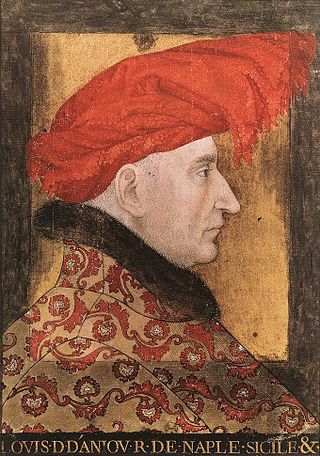
Louis II was Duke of Anjou and Count of Provence from 1384 to 1417; he claimed the Kingdom of Naples, but only ruled parts of the kingdom from 1390 to 1399. His father, Louis I of Anjou—the founder of the House of Valois-Anjou—was a younger son of King John II of France and the adopted son of Queen Joanna I of Naples. When his father died during a military campaign in Naples in 1384, Louis II was still a child. He inherited Anjou from his father, but his mother, Marie of Blois, could not convince his uncles, John, Duke of Berry and Philip II, Duke of Burgundy, to continue her husband's war for Naples. The Provençal nobles and towns refused to acknowledge Louis II as their lawful ruler, but Marie of Blois persuaded them one after another to swear fealty to him between 1385 and 1387.

Lamanon is a commune located in the Bouches-du-Rhône department, part of the Provence-Alpes-Côte d'Azur region in southern France. Its inhabitants are called Lamanonais in French.
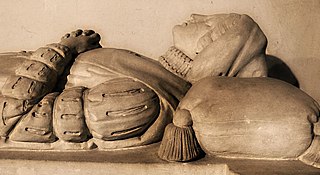
Beatrice of Savoy was Countess consort of Provence by her marriage to Ramon Berenguer IV, Count of Provence. She served as regent of her birth country Savoy during the absence of her brother in 1264.

The County of Provence was a largely independent medieval state that eventually became incorporated into the Kingdom of France in 1481. For four centuries Provence was ruled by a series of Counts or Marquises of Provence. They were nominally vassals of the crumbling Carolingian Empire, of Burgundy, Catalonia, or the Holy Roman Empire, but in practice they were independent rulers.
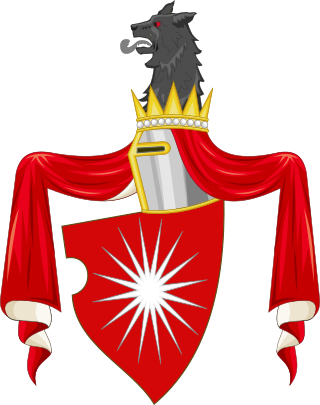
The House of Baux is a French noble family from the south of France. It was one of the richest and most powerful families of medieval Provence, known as the 'Race d’Aiglon'. They were independent lords as castellans of Les Baux and Arles and wielded very considerable authority at the local level. They held important fiefs and vast lands, including the principality of Orange.

The Capetian House of Anjou, or House of Anjou-Sicily, or House of Anjou-Naples was a royal house and cadet branch of the Capetian dynasty. It is one of three separate royal houses referred to as Angevin, meaning "from Anjou" in France. Founded by Charles I of Anjou, the youngest son of Louis VIII of France, the Capetian king first ruled the Kingdom of Sicily during the 13th century. The War of the Sicilian Vespers later forced him out of the island of Sicily, which left him with the southern half of the Italian Peninsula, the Kingdom of Naples. The house and its various branches would go on to influence much of the history of Southern and Central Europe during the Middle Ages until it became extinct in 1435.

La Barben is a commune in the Bouches-du-Rhône department in the Provence-Alpes-Côte d'Azur region of southern France.
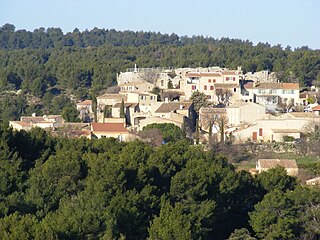
Aurons is a commune in the Bouches-du-Rhône department in the Provence-Alpes-Côte d'Azur region of southern France.
The architecture of Provence includes a rich collection of monuments from the Roman era, Cistercian monasteries from the Romanesque period, medieval castles and fortifications, as well as numerous hilltop villages and fine churches. Provence was a very poor region after the 18th century, but in the 20th century it had an economic revival and became the site of one of the most influential buildings of the 20th century, the Unité d'Habitation of the architect Le Corbusier in Marseille.

Andon is a commune in the Alpes-Maritimes department in the Provence-Alpes-Côte d'Azur region of southeastern France.
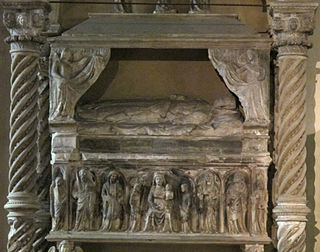
Maria of Calabria, Countess of Alba, was a Neapolitan princess of the Capetian House of Anjou whose descendants inherited the crown of Naples following the death of her older sister, Queen Joanna I.
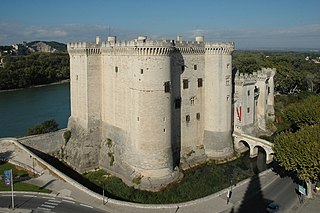
The historic French province of Provence, located in the southeast corner of France between the Alps, the Mediterranean, the Rhône river and the upper reaches of the Durance river, was inhabited by Ligures beginning in Neolithic times; by the Celtic since about 900 BC, and by Greek colonists since about 600 BC. It was conquered by Rome at the end of the 2nd century BC. From 879 until 1486, it was a semi-independent state ruled by the Counts of Provence. In 1481, the title passed to Louis XI of France. In 1486 Provence was legally incorporated into France. Provence has been a part of France for over 400 years, but the people of Provence, particularly in the interior, have kept a cultural identity that persists to this day.
References
- ↑ Alain Venturini, Vérité refusée, vérité cachée : du sort de quelques nouvelles avant et pendant la Guerre d'Union d'Aix (1382- 1388), Actes des congrès de la Société des historiens médiévistes de l'enseignement supérieur public. 24e congrès, Avignon, 1993. p. 180.
- ↑ venturini pg. 182
- ↑ Geneviève Xhayet, Partisans et adversaires de Louis d'Anjou pendant la guerre de l'Union d'Aix Archived July 23, 2015, at the Wayback Machine , Provence historique, Fédération historique de Provence, volume 40, no.162, Autour de la guerre de l'Union d'Aix, 1990, p.g.404-405
- ↑ Étienne Charles Rouchon-Guigues, Louis Saudbreuil - Résumé de l'histoire de l'état et comté souverain de Provence ici
- ↑ venturini p.g.183.
- ↑ Jean-Pierre Papon, Jules Frédéric Paul Fauris de Saint-Vincens - Histoire générale de Provence, page 255 read online
- ↑ Louis Stouff, Arles au Moyen Age, page 101
- ↑ venturini pg. 183